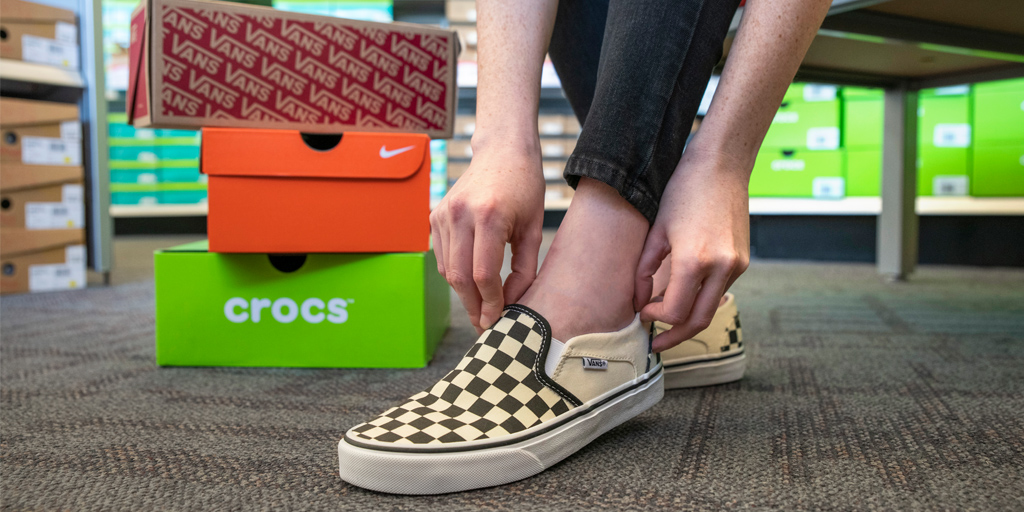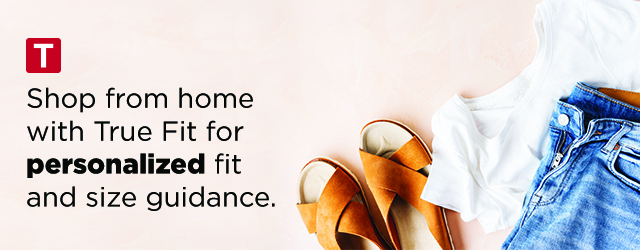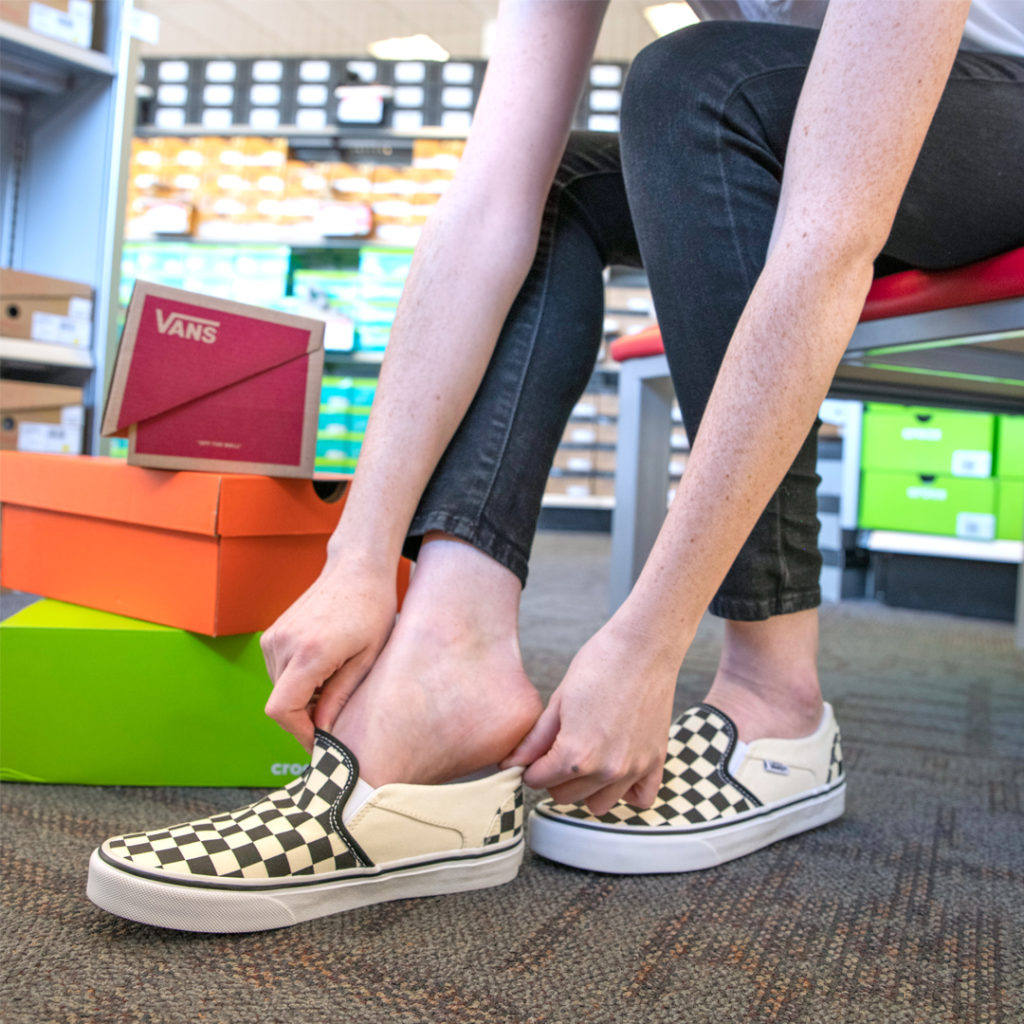Find Your Perfect Fit with Shoe Carnival!

In part one of our four-part series, learn how to measure for the perfect fit every time – whether you’re shopping in store or online.
It’s important that you love your look, and the size and fit of your shoes are just as important as the style. Whether you’re going out for a night on the town or running laps in the neighborhood, put your best foot forward with a shoe that fits as great as it looks. Check out the list below of frequently asked questions about shoe sizing and make sure your next shoe purchase is the perfect fit.
“How Do I Measure My Foot and Find My Shoe Size?”
Your shoe size may seem like a trivial fact about yourself, like your favorite color or your high school mascot. In reality, wearing properly fitted shoes is critical! Shoes that don’t fit are more than just uncomfortable – they could damage your foot health in the long run.
You can successfully measure your foot easily at home. Shoe Carnival has printable size charts for kids, men, and women with easy-to-use instructions that will make finding the right fit easy.
Don’t have a printer? You can still find your size at home by following these simple steps:
- Gather Your Supplies: All you need to measure your foot at home is a piece of paper larger than your foot, a pencil or another writing tool, tape, and a ruler or measuring tape. If you plan to wear the shoe with socks, we recommend you wear socks for tracing.
- Trace Your Foot: Start by taping the paper down and placing your right foot on top of the paper. Sitting on a chair with your right foot firmly on the floor, bend your leg forward so that your shin is slightly in front of your ankle, and trace the outline of your foot. Make sure you’re holding the pencil or pen upright (not at an angle) snugly against the edge of your foot.
- Mark the Length and Width of Your Foot: Using your pencil or pen, draw straight lines that are touching the outermost points at the top, bottom, and on both sides of your foot outline.
- Measure the Length of Your Foot: Holding your ruler or measuring tape straight, use your ruler or measuring tape to measure the length in inches from the top of the line to the bottom line that you did in step three. Find the closest mark you can and write this number down.
- Measure the Width of Your Foot: Use your measuring tape or ruler to measure the width in inches from one side of your tracing to the other side. Find the closest mark you can and write this number down.
- Repeat on the Other Foot: Repeat steps 2-5 on the left foot and compare the measurements of both feet. Keep the larger numbers for both width and length, as it’s always better to have more room than not enough.
- Adjust for Error: Subtract 1/16 of an inch from your length and width measurements. This is to accommodate for any slight spaces caused by tracing.
- Find the Perfect Fit: The final numbers are your foot measurements! Check out our Size Chart to find your perfect fit!
“What’s the Best Time to Measure My Feet?”
We recommend that you wait until the afternoon or evening to measure your feet because feet swell and expand throughout the day. This is particularly important when measuring children’s feet to ensure the best fit for your little one!
“How Do Kids’ Shoe Sizes Work?”
Children’s shoe sizes start at a 0 and run through a 13 ½. Then, they start back over at 1 and go up to a 7. This may sound confusing, but it is very easy to tell the difference between the little size 1 and the big size 1.
Have additional questions about kids’ shoe sizes? Check out our Size Chart for more information.

“What Does the Letter in the Shoe Size Mean?”
A letter at the end of a shoe size indicates the width of the shoe. There are two common scales used to indicate shoe width. One scale simply uses “N” for narrow, “M” or “R” for medium or regular width, “W” for wide, and “EW” for extra wide.
The other scale uses letters AA through EEEE, with AA being the narrowest width and EEEE being the widest. In general, a B width is equal to a women’s medium width, and a D width is equal to a men’s medium width and a women’s wide width. For example, a women’s 8D, a women’s 8W, and a men’s size 6M would all be approximately the same width.
Have more questions about width? Check out our Size Chart for more information.

“What Brands are Better to Size Up or Down In?”
Some brands naturally run shorter, longer, wider, or narrower than others – but you should never have to guess which size will fit you best. To make sure you get the perfect fit every time, Shoe Carnival partners with True Fit, a data-driven personalization platform. True Fit takes manufacturer design data, anonymous consumer order data from across the web, and product feedback from hundreds of millions of shoppers to generate the best sizing recommendation for any shoe on our site.
Also, Shoe Carnival has brand-specific size charts and expert sizing information on select product pages. For instance, if you’re new to the Birkenstock brand or European sizing in general, you’ll want to check out the Birkenstock size chart!
“If I’m Between Two Shoe Sizes, Should I Size Up or Down?”
If you’ve tried True Fit and the size chart, but you’re still between two sizes – size up! It’s usually better to have a little extra room than not enough.
The only exception to this rule is people with narrow feet. If you have narrow feet and no narrow size option is available, size down instead of up.

“How Should My Shoes Fit?”
There should be between 3/8” to 1/2” of room between your longest toe and the end of your shoe. If you find that you can’t wiggle your toes effortlessly in closed-toe shoes, your shoes are likely too small for your foot. Another way to easily test this is by doing the “Finger Test” – pushing your toes to the end of the shoe, you should be able to slide your index finger between your heel and the heel of your shoe easily and snugly. When trying on sandals, make sure your longest toe does not overhang the edge of the shoe.
Many of us wear shoes that are too narrow. Wearing shoes that don’t fit can contribute to long-term foot health issues, so it’s key to understand if your shoes are securely snug or far too tight. One tell-tale sign that your shoes are too narrow is that they smash your toes or leave bruises on your foot.
There is also a chance that your shoes could be too big or too wide! If your sneakers or oxfords are only comfortable when you pull the laces extra tight, there’s a good chance you’re in too wide of a size. If you’re someone who enjoys wearing heels and pumps, check to see if your heels are popping out of the back of the shoe or if the back of your heel is blistered after wearing. If they are, then the shoes are too big or too wide and you should think about sizing down.
“How Should Running Shoes Fit?”
Most runners prefer a half size larger than what they would normally wear in their everyday shoes for optimum comfort. Running shoes are different than your usual casual canvas shoes – you’ll be more active in a shoe designed for sprints, jumps, and running, so your feet may be more prone to temporary swelling. Wearing running shoes that are too small can cause blisters and other problems for your feet. So, size up and allow for a little extra breathing room for those toes!
No matter your shoe size, you’re sure to find your perfect fit at Shoe Carnival!
